Party: Tim Vollmer, Kosta Seiler, Adrian Spragg and Mike Arrell
The Blue Mountains are home to a huge number of diverse and spectacular canyons, with many dozens coming complete with detailed trip notes, easy access, tracks, good anchors and in some cases even sign posts or log books!
But head up north, into the Wollemi, and there are even more spectacular slot canyons in a remote and rugged wilderness area where the fittest, keenest and most experienced canyoners are still making new discoveries and carrying out first descents.
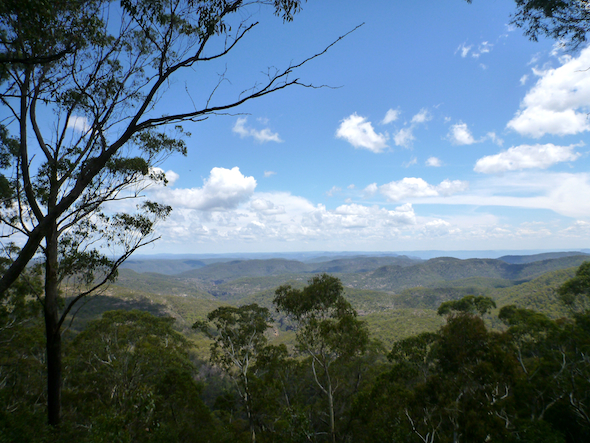
For a couple years this area has been at the back of my mind. Not so much to go hunting for new canyons — there’s plenty of time for that in future — but simply to get out into this trackless wild place and explore some of these pristine sandstone constrictions, with all the physical and technical challenges they bring with them.
After much talk I finally took time off from work, narrowing down a seven day stretch of time with T1 along with an area right in the middle that we wanted to explore first.
We were to be joined by Kosta, Adrian and Mike, and while everyone was experienced with off-track walking, pass finding, canyoning and rope work, not one of us had ever set foot in this area.

Disaster struck the night before our departure, with T1 offered a new job at 5pm on the condition he start within weeks. Suddenly we were out not only an experienced person, but more importantly our transport! We resorted to my crappy Falcon, which actually handled the dirt roads admirably, and Adrian made a quick dash to pick up the ropes T1 was bringing. T1 admitted that he was committing a cardinal sin, and as penance accepted that he would be bad-mouthed not only on the trip, and in the trip report, but would be forever known as ‘The Piker’ (okay, so my title for him was actually much more offensive than this).
Those of us who weren’t pikers met up at Penrith Station the next morning before hitting the road. The drive took us through Lithgow, north towards Mudgee, back and forth between Kandos and Rylstone a couple times (who knew there were towns with no chemist), past a take away joint for an early lunch and then on to Dunns Swamp.

None of us had been to Dunns Swamp before (it is a spectacular little lake between sandstone pagoda formations formed by a dam built 80 years ago for the Kandos cement works) so we swung past briefly to look around at the camping facilities.
From here it was a short way east to the old Army Road which crosses over the Great Dividing Range then follows the Wollemi Range into the heart of the Coorongooba area.
We dumped the car, slung on our heavy packs (imagine the weight of a week long bushwalking pack and throw in ropes, harnesses and other canyoning paraphernalia!) and set off along the road.

Soon we were dealing with the brutal climb up Mt Darcy, with the road taking us to almost 1100 metres as we crossed the Great Dividing Range. Not far after the peak we surprised a huge wedge tailed eagle that was drinking from the unmarked dam nearby. It took flight, its enormous wingspan covering the full width of the old road, before landing a short distance away, then again taking flight and heading into the valley. None of us had ever been so close to one of these majestic birds.
Our plan was for a massive road bash on this first day, of about 30 kilometres depending on how we went, then to work our way back towards the car later in the week.

It was a stinking hot day, with high humidity, and we were baking as we walked. Not far after Cyrils Rocks we decided we needed a break, finding a shady spot near a small soak for a siesta while some of the heat went out of the day.
Eventually we got moving again, moving at a fairly cracking pace, before deciding on a camp site that was about 3kms short of our initial planned destination. In the last of the twilight we set up camp in a nice, if slightly scrubby spot, which ended up being our home for the rest of the week.

The next morning we set off for a nearby creek. We dropped into one branch, finding a very pleasant canyon with several abseils. At the end of this upper section we clambered over a ridge and dropped into the other branch. This also had several abseils, but wasn’t really a canyon. Just after the junction of the two creeks we dropped into a very nice, deep constriction. It was lush and green, with several abseils and some scrambles, before it opened out just as another large tributary joined in.
We forced a pass up between these two creeks, which was mainly easy going, but the final layer of cliffs posed a real challenge, with a slight overhang continuing for a long distance. Eventually we found a very exposed break and were up, with the help of a pack haul. We got back to camp mid-afternoon where we had a late lunch then relaxed.

One of the big challenges of exploring remote canyons is that everything is loose. While regular canyons have had other people moving through to settle things down, in these ones we found even large boulders were often precariously balanced, rolling when you stood on them. Logs would dislodge. Sand would sink, at times thigh deep. Strong looking holds on scrambles would crumble and break. This created some serious challenges all week.
The next morning we decided to head further afield, checking out two creeks which flow directly into Coorongooba Creek. We made really good time walking out a ridge, which caused us to overshoot our creek, so we made our way to a rocky platform overlooking the surrounding area to confirm our mistake. A backtrack of about 300m took us to a small gully which we started dropping into.
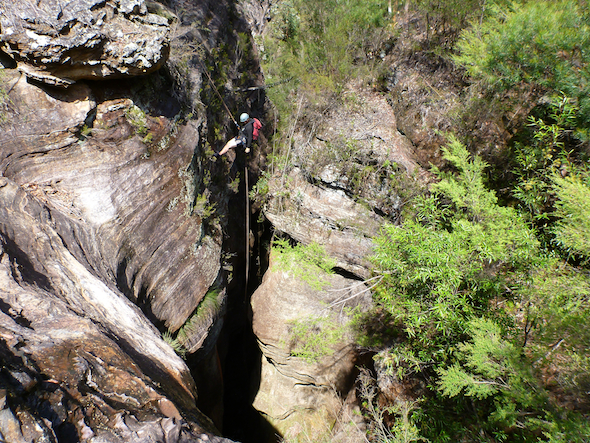
We quickly came to an abseil down a short and open slot which had a couple cool arches. It was then further downstream to a spectacular hole that drops deeply into the earth. Rather than abseil down the slot we came in from a large tree on the side, hoping it would provide an easier pull down of our ropes.
This abseil was great fun, and it was just the beginning. We had more than half a dozen abseils, and countless scrambles and climb downs, as this creek dropped further and further. Every time you thought it must be the end, another drop would open up in front of you.
Eventually we hit Coorongooba Creek where we ate lunch on the sandy bank under the shade of a spectacular stand of Blue Gums.

From here we walked a short way upstream before heading up a steep ridge to the headwaters of our next creek. Despite neighbouring our last canyon, this one was totally different. The first had been surrounded by dry, open scrub, while this one was a lush rainforest.
Soon we started dropping, again through an impressive vertical canyon. We did about a dozen abseils, several hand-over-hand’s and countless climb downs. It felt like we had dropped further than we had climbed up the ridge, and must be heading for some sub-terrainian creek system!
Eventually the canyon came to an end with some spectacular wave-shaped cliffs — a feature of several canyons around here — as well as some quick sand that gobbled Mike up briefly.
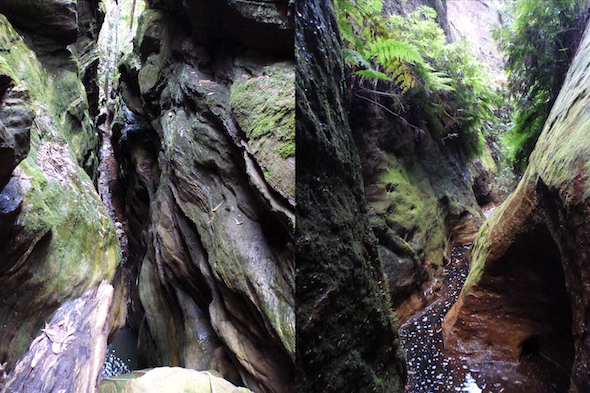
By the time we were back at camp it was almost dark, and we were totally exhausted, especially as we had to finish each day by lugging several litres of water back to our high camp site.
The next morning my feet were killing me, thanks to some serious blisters, which I attribute in a large part to the dodgy pair of new Volley’s I’d worn (see comment at the end of this trip report for more on my complaints). It was enough to convince me that a rest day was in order, so I bid the other three adieu and climbed back into my sleeping bag.

From what I was told that night, I missed a cracker of a canyon. The first one only had about three abseils, but it had a long, dark, impressive constriction.
From where this canyon joined a larger tributary the guys forced their way upstream, at one point standing on shoulders to get up a small waterfall, before finding a very cool pass at the junction of two smaller creeks. Mike set off back to camp, while Kosta and Adrian decided to explore one more canyon. This one had a number of abseils, but was very open and quite disappointing. I was happy to hear this as it meant I’d only missed one good canyon!

The next day it was Mike’s turn to have a rest day, so the rest of us set off on a long walk out a ridge to a more remote canyon that ran parallel to the good one from the day before. It was a pleasant canyon, with some nice drops and good formation, but nowhere near as dark or impressive as its neighbour.
At the end we walked about 500m up the deep gorge before retracing the steps of the day before, including the waterfall climb.
We discovered Adrian’s maps had gotten wet, and my waterproof camera was also leaking, so we laid them out to dry while we had lunch then set off to another canyon that ran close to the disappointing descent from the afternoon before.

This canyon was quite good. It had quite a number of abseils, some quite large, with each of them landing us in big, deep, round pools of water.
Finally it was back to collect the wet stuff, which had thankfully dried, then up the impressive zig zag pass which the guys had found the day before. This was very reminiscent of the cliffs above the Colo River.
We were all enjoying ourselves so much that by this point in the trip it was pretty well decided that we’d stay on for an eighth day and try and do an extra canyon or two. Despite how hungry we were getting thanks to the big days, we all managed to ferret away enough food to pull this off.
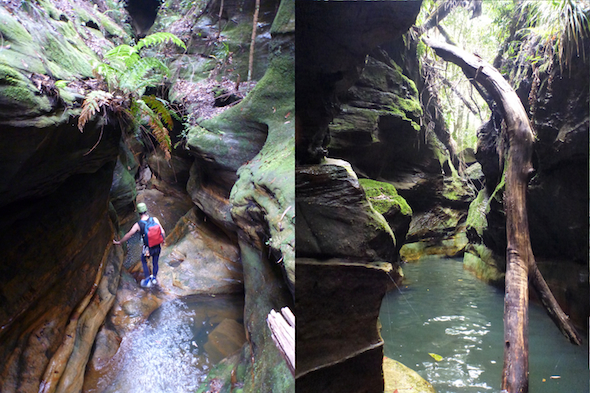
The next day it was Kosta’s turn to pike. Up until this point the weather had been warm and muggy, with a couple very minor showers, but for the last two days the rain increased, making some of the canyons rather chilly and progress less pleasant.
Our first canyon had us gearing up in a stunning little dell, where a lyrebird decided to run though its enormous collection of bird calls to keep us entertained. Adrian described this one as being like an outdoor gym, with plenty of scrambles and down-climbs in addition to the three abseils.

At the end we joined a larger creek, following it upstream to one of several ancient volcanic vents that have left large, lush bowls in the middle of the rocky terrain. From here we made out way up and over a ridge and into another creek.
We dropped in high, as most of our creeks had contained small upper canyon sections. This one, unfortunately, only contained scrub and fallen timber. We struggled for a long time, getting to the point where we thought there would be no canyon, when it suddenly started to open up.
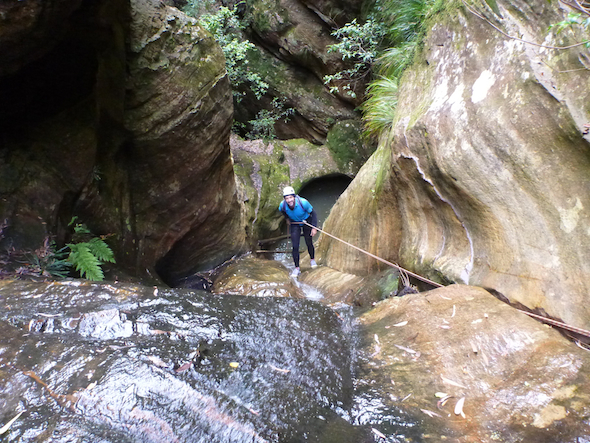
Down we plunged, with several long abseils, into a very deep, dark and narrow canyon. The sheer cliff walls were scrubbed clean, with not even moss. One of the drops required some imagination to form an anchor. I jammed a rotten bit of wood in a narrow section, kicking it to make sure it stuck fast, then rigged up.
The guys kept a foot on it to make sure it didn’t slip as I dropped more than 20m down a waterfall. I claimed to have taken the most risk, but Adrian rightly pointed out that going last meant he was the only one without someone ensuring the anchor stuck fast.
Amazingly it even stayed put for the awkward pull down, even after the rope almost jammed, which convinced the other two that it hadn’t been anywhere near as dodgy as it looked.

This canyon ran right down to the junction with a larger creek, with a horizontal canyon starting immediately from this point. It was very pleasant, but never very narrow or dark.
We tossed up reversing this canyon, but instead pressed on a bit further, stopping for lunch over a warming fire near a creek junction where a promising cleft ran up the cliff, offering a likely pass.
The pass was wonderful, taking us steeply but directly up the large cliffs. There was plenty of loose ground (at one point a large tree stump starting to slide, catching the rope on Adrian’s back and dragging him about a metre backwards as well as nearly taking me out) that made things a little more challenging.
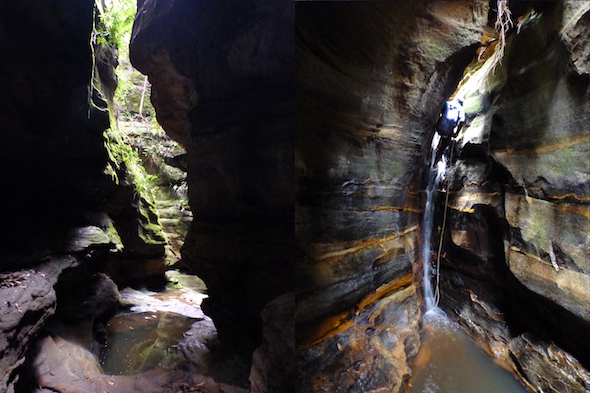
This convinced us not to hang about, so we pushed on up. Once on top we followed a long, scrubby ridge, finally breaking out into the open just metres from our camp site.
With the weather being particularly miserable that night — most of us cooked dinner under our flys — there was a growing consensus that we should abandon the plans for an extra day of canyoning and simply head for home.
The next morning we packed up our camp and set off for the return road bash, admiring how much lighter our packs now were. We had in the back of our mind a plan to do one or two canyons on the way if the weather improved, but when we reached the area an hour or two later there was still a thick, cold mist and regular showers of rain.
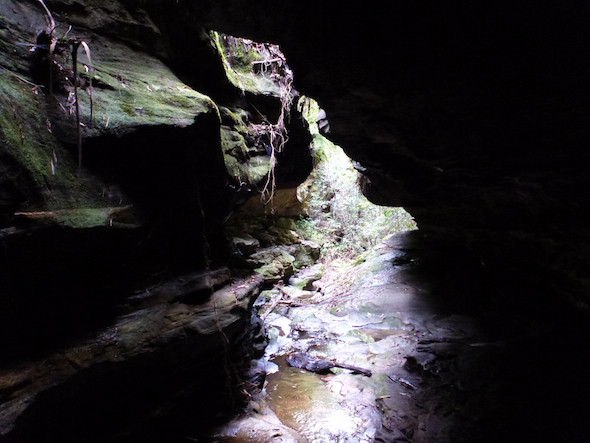
The slog wasn’t too bad, until we started the big climb back over the Great Dividing Range. We passed the locked national park gate, climbing steeply up onto Mt Boonbourwa. Adrian and Mike paused for a light lunch near the grassy knoll on the way up, but Kosta and I, desperate to get back to the car, pressed on.
It was pretty easy walking once we got up on top of the range, and we quickly crossed Mt Duran Duran (I assume this obscure peak wasn’t in fact named after the 80’s super group) and the evil Mt Darcy that had tortured us on day one. From here it was a big, long downhill on a fairly slippery road surface — made worse by the rain — so we were most thankful when we hit the bottom of the hill.

We continued to the car, with Kosta and I just finishing getting changed when the other two arrived.
We raced towards Rylstone for a late lunch, but by the time we got into town the pub kitchens had closed, as had most of the takeaway shops, so the only option was some reasonable, if overpriced, burgers.
It seemed strange to be back in civilisation after a week of not so much as seeing a footprint that didn’t belong to us. Given some better weather I think we’d have all much preferred to stay in the bush, although the lure of a nice hot shower was pretty enticing.


Below is my letter of complaint to Pacific Brands, maker of the Volley, regarding the poor quality of their new design. If you have had a similar issue I’d encourage you to also send an email to them: http://www.volley.com.au/contacts/
I am writing to complain about the quality of the new Volley.
I have been wearing these shoes exclusively for canyoning and bushwalking activities for about four or five years, after being convinced to abandon walking boots. Since making that move I have been a strong advocate for the Volley, with the quality of grip afforded by the herringbone rubber perfect for outdoor pursuits, especially on wet rock. Not only do I normally go through four to six pairs a year, I have bought them for my wife and children, and encourage people I take canyoning to invest in a pair. Given that I regularly run introductory weekends for a large bushwalking club, this has no doubt led to a large number of sales for Dunlop!
Last week I went on a seven day canyoning trip in the Northern Blue Mountains. I was wearing a pair of the new Volleys. Another member of the group wore an old style pair. Both were new (mine had been used for a short stroll of less than 3kms). The level of wear was shockingly different.
By day three, my soles were almost completely bald, while the old style Volleys remained almost perfect. I noticed a rapid deterioration in grip, which also made it a safety issue. I also noticed blisters on the balls of my feet — something that has never occurred before in these shoes — which coincidentally were directly above the exposed piece of string that now runs on the inside of the soles. I cut this string out, which helped my feet, but the bad wear continued. Despite taking a rest day (so the old style pair had an extra 10kms plus of walking and two additional canyons) the level of wear on my shoes remained significantly worse.
By the end of the walk my soles were completely bare, with dark patches on the heel and ball indicating the rubber was almost worn through (I can provide a photo by email if this assists). I was actually concerned I would not safely make it to the end of the trip and was planning to tape a pair of thongs to the soles of my Volleys. Even the inner had given out, with holes forming and the foam starting to disintegrate.
This is the first time I have considered moving away from the Volley to a specialist canyoning shoe. It is not a choice I want to make, but I feel that if there is no improvement in quality it will be one I am forced into.
I would appreciate a call to discuss my concerns. I would also appreciate a refund for this pair of shoes, as well as a swap of the two other new style Volleys I was given at Christmas for remaining old style stock.
Hi Tim
I just stumbled on your website and volleys post so I’m a bit out of date. I have always loved volleys for their reasonable stickyness and pliability when rock hopping through canyons. But things have obviously changed in terms of their quality.
I went canyoning in the Nth Wollemi for 7 days late in March. For that I bought a brand new pair of volleys. Although the sole did not fail like yours, the fabric sides started to peel away from rubber edge of the sole at day 3. By day 7 they were barely hanging together. I deposited the volleys in a bin when I got home. A member of our group trialled Five Fingers KSO Trek … much to the bemusement of the rest of us. He had foot/ankle problems so was trying these as an alternative. By the end of the trip, we were moderately impressed with them. He also used them in Fireball and Hole in the Rock last weekend. Apparently they give as much if not better feel for the rock as the volleys. Given that volleys are wearing out faster than 10 years ago, i’m now contemplating trialling the Five Fingers ($250). I’m not sure on their benefit/cost. If volleys at $40 last five days, then the Five Fingers have to last at least 30 days to make them price competitive. (So that you know, I’ve also tried 5:10s doing Bungonia canyon and found that they were sticky but way too rigid for easy rockhopping … i didn’t like them.)
Cheers
Monika
Monika,
That’s great feedback. I’ve only seen the Five Fingers used once in a canyon, and they seemed to do well. That said, it was only Hat Hill Ck, so not a real test. I’m really to hear your feedback if you do more testing with them. I’ve been enjoying the 5.10’s, but would like to find something lighter. The cost issue is a challenge with every option, given how quick canyons wear things, but there has to be a better solution than the new volleys!
Looking at the map, I think you were near(ish) to Wollemi Pine country
Not really. Considering the well known GPS locations for three strands of pines:
First location: Zone 56H: 0335100E 6251300N
Second location: Zone 56H: 0293900E 6227800N
Third location: Zone 56H: 0260500E 6286150N
Hahaha… nicely played Kosta.
I particularly like the fact that the person who published those locations described the nearby terrain as containing “endless square-shaped pagodas, some of immense height, dissected by incredible networks of structural lineations along which the wildlife, entirely feral and in plague proportions, travels very fast and ferociously indeed.” (http://www.bushwalking.org.au/bushwalking/bushwalkingmag/mag2727.html)
But to be serious, we did actually make it to within 20 metres of a large group of Wollemi pines on the first day of our trip. The exact location of the trees can be found here: https://maps.app.goo.gl/Sp1VcaiEtCdtHR1B6
But that description of the large square pagodas is only accurate for the first stand of pines! 🙂 You’d want to be well prepared before visiting that part of NSW!
Cheers, Min
A couple of alternatives to the 30k road bash…
If you stay at wildernessbunkhouse.com (32.876733S 150.266397E), if they like you they can grant you access down the Army Road as they own property in the park.
Prior to the bunkhouse, we walked in the Army Rd to the saddle where you turn off for ********* Canyon, headed east did ******* canyon, crossed Numietta Ck and camped in a cave on the ridge. We did ******** and ******** then on our hike out went through *********** (not a good idea with full packs, it’s narrow in spots).
You can head up the ‘gooba from Glen Davis. We’ve continued up Running Stream Creek and found a pass or two (and the odd Death Adder) to get onto the ridges.
But I wouldn’t suggest the pass via the memorial cairn at 33.144351S 150.368434E… spiky bushes!
Cheers, Min
Min, thanks for that. Firstly, sorry for editing your post (given the arguments on OzCanyons I didn’t want to leave in specific names).
I have to check the wilderness bunk house out some time, especially if the plan is to do canyons around Numietta Ck. We were operating quite a way to the east on our trip, so this wouldn’t have been much help. It was a toss-up between going the way we did and heading from Glen Davis, but wanted to work my way back north, specifically for an area with a very distinctive rocky ridge that looks like it has a great canyon next to it. Maybe next time!
No prob with the redaction 🙂
We’ve stayed at the bunkhouse a couple of times now. Costs more, but becomes a very civilised way to do some of the Numietta canyons.
Two more recent trips were from the Glen Davis end, exploring Running Stream:
https://www.facebook.com/media/set/?set=a.10150611672659942.487243.550529941&type=3
Cheers, Min
Just finished our week of Coorongooba canyoning. 2 of us rode in on mountain bikes and met up near the Gospers / Army Rd junction with 3 who climbed up from Glen Davis. Any of your gang lose a knife at the top of a pitch? Not a fancy one.
The last photo looks familiar, but we were scaredy cats and slid down on our bums before jumping to the side 🙂
Cheers, Min
I don’t recall the loss of a knife, but we could have. I’ll email the others to check.
Is anyone prepared to say if the coordinates for the wollemi pin posted by the heroic bushwalker are real?
Just curious
All the locations for pines listed on this thread are absolutely real. I highly recommend you visit any of of the stands listed.
For real Tim? I am surprised such a well kept secret is so easy to crack. But I guess knowing the locations and getting to them is a different matter.
No, the three locations listed are all easily accessible.
Punch them into a GPS and you’ll get the gag!